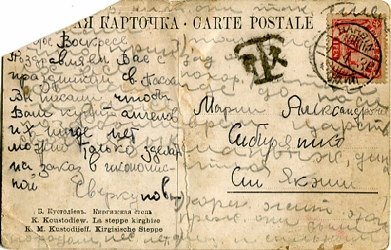
Cliquez sur les images pour agrandir -

LETTRE
9 avril 1936 -
–
April 9th, 1936 -
|
Dimensions : |
140 x 90 mm |
|
|
Tarif : |
Carte postale locale :……..….. |
1 fen |
|
Période de valeur : |
Du 26/07/1932 au 17/11/1940 |
|
|
Timbre utilisé : |
Fiscal n°FX77 (1) |
|
|
Oblitération : |
N°43.1 Harbin 9/04/1936 |
|
|
Période d’utilisation : |
1ère date rencontrée |
|
|
Indication : |
Cachet « 資T欠 » taxe (quiàn zī ) |
|
|
Arrivée : |
NC |
|
|
Size : |
140 x 90 mm |
|
|
Rate : |
Local postcard :………………… |
1 fen |
|
Period of rate : |
07/26/1932 to 11/17/1940 |
|
|
Stamp : |
Revenue n°FX77 (1) |
|
|
Cancellation : |
N°43.1 Harbin 04/09/1936 |
|
|
Period of use : |
First date |
|
|
Instruction : |
Cancel « 資T欠 » tax |
|
|
Arrival : |
NC |
|
Carte postale très surprenante pour plusieurs raisons.
Première raison : le texte, ou plutôt les textes qui sont en russe et mal écrits. Le premier -
« Ada, Le Christ est ressuscité. Je vous souhaite une belle fête de Pâques. Vous nous avez écrit pour qu’on vous achète des anges. Il n’y en a nulle part. On peut seulement passer commande chez un artisan » ?
Signé : « Evrkounov » ?
Destinataire : « Maria Alexandrovna Sibiriatko ». Quartier ou rue, si nous sommes à Harbin (2) : « Sil ? Sich ? Iakèich ? »
Le second texte, lui aussi en russe, beaucoup moins lisible, semble avoir été ajouté entre les lignes du texte initial. Cet ajout a été réalisé après la réception de la carte puisque certains mots viennent au-
Seconde raison la taxation : D’une manière générale, le courrier, quel qu’il soit, est taxé par le bureau d’arrivée. Si l’expéditeur a glissé la carte postale dans la boite aux lettres sans l’affranchir ou, que le timbre, étant mal collé, s’est détaché durant le transport (on aperçois un fragment d’oblitération, plus clair, du côté gauche du timbre), à l’arrivée, la carte est taxée pour insuffisance d’affranchissement -
Enfin, une autre possibilité qui m’a été inspirée par une remarque d’un de mes correspondants. A cette époque, au Japon, il était possible d’affranchir le courrier avec des timbres fiscaux si l’on ne disposait pas de timbre-
(1) Source : Catalogue spécialisé du Mandchoukouo p 306
(2) Ce que, faute de lisibilité du texte, je considère comme étant la destination


A very surprising postcard for several reasons.
The first reason is the text, or rather the texts, which are in Russian and badly written. The first -
"Ada, Christ is risen. I wish you a happy Easter. You wrote to us asking us to buy you some angels. There are no angels anywhere. Can't we just place an order with a craftsman"?
Signed: "Evrkounov"?
Addressee: "Maria Alexandrovna Sibiriatko". Neighbourhood or street, if we are in Harbin (2): "Sil? Sich? Iakèich"?
The second text, also in Russian, is much less legible and appears to have been added between the lines of the original text. This addition was made after the card was received, as some of the words appear above the stamp and cancellation. It is therefore possible that this card was put back in an envelope and then posted again...?
Secondly, taxation: Generally speaking, all mail is taxed by the office of arrival. If the sender has put the postcard in the letterbox without franking it, or if the stamp has come off during transport because it has not been properly stuck on (a fragment of the cancellation can be seen on the left-
Finally, another possibility inspired by a remark made by one of my correspondents. At that time, in Japan, it was possible to frank mail with revenue stamps if you didn't have a postage stamp. As Manchukuo was under Japanese 'influence', it is possible that this letter is an example. This would explain the 1 fen tax stamp (local rate) which, thinking he was within his rights, the sender stuck on the card. The postman, on the other hand, considered that the card had not been stamped correctly and taxed it.
(1) Source: Specialised Catalogue of Manchukuo p 306
(2) What, for lack of legibility of the text, I consider to be the destination